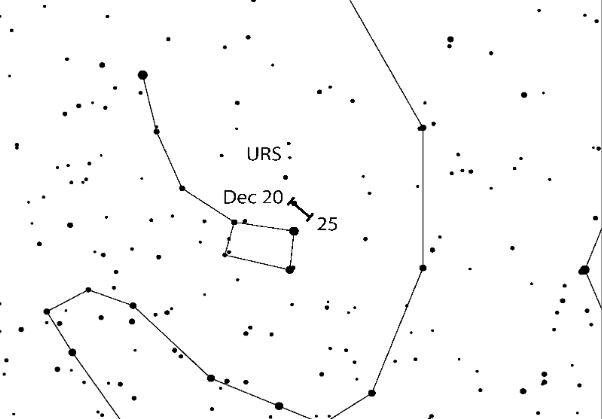Despite bad lunar conditions in 2018, the Ursids activity should be carefully checked, as a potential outburst could occur on December 22, between 19h and 22h UT.
The Ursids are one of the last meteor showers of the year, and they are medium active. But despite this, it’s a poorly monitored meteor shower due to the uncomfortable observing conditions, the unstable winter weather in the Northern hemisphere, and the proximity between the activity period of the shower to the Christmas holidays. Linked to the periodic comet 8P/Tuttle, the Ursids are nonetheless a very interesting shower which produced several activity outbursts over the last decades, especially in 1945 and 1986. But more recent activity enhancements have also been reported during the 2006-2008 period, as well as in 2011 and 2014. This year, Peter Jenniskens predicts that the Earth may cross a meteoroid filament on December 22, between 19h and 22h UT, which could lead to another activity enhancement.

Unfortunately, this year, observing conditions can’t be worse, as the Moon will be full on December 22. But monitoring the activity of the shower despite these unfavorable conditions will be interesting, to monitor the activity of the stream, and detect (or not) the Ursids filament. The classical maximum is predicted around the same time, on December 22, around 21h UT. Depending on your observing site, the situation will be more or less favorable: the Ursids radiant is located near Kochab (beta UMi), and is thus circumpolar for most of Northern hemisphere observing sites. But it’s at its lowest position in the sky at the beginning of the night, and it’s at its highest position in the sky before dawn. Best is then to survey Ursids at the end of the night, but observers for which the radiant is at lower position when the outburst is predicted should not dismiss observations, as all information regarding this event are highly welcome for future predictions.
Please submit your visual observations at https://www.imo.net/members/imo_observation/add_observation
Clear skies!




 You saw something bright and fast? Like a huge shooting star? Report it: it may be a fireball.
You saw something bright and fast? Like a huge shooting star? Report it: it may be a fireball.  You counted meteors last night? Share your results with us!
You counted meteors last night? Share your results with us!  You took a photo of a meteor or fireball? You have a screenshot of your cam? Share it with us!
You took a photo of a meteor or fireball? You have a screenshot of your cam? Share it with us!  You caught a meteor or fireball on video? Share your video with us!
You caught a meteor or fireball on video? Share your video with us!